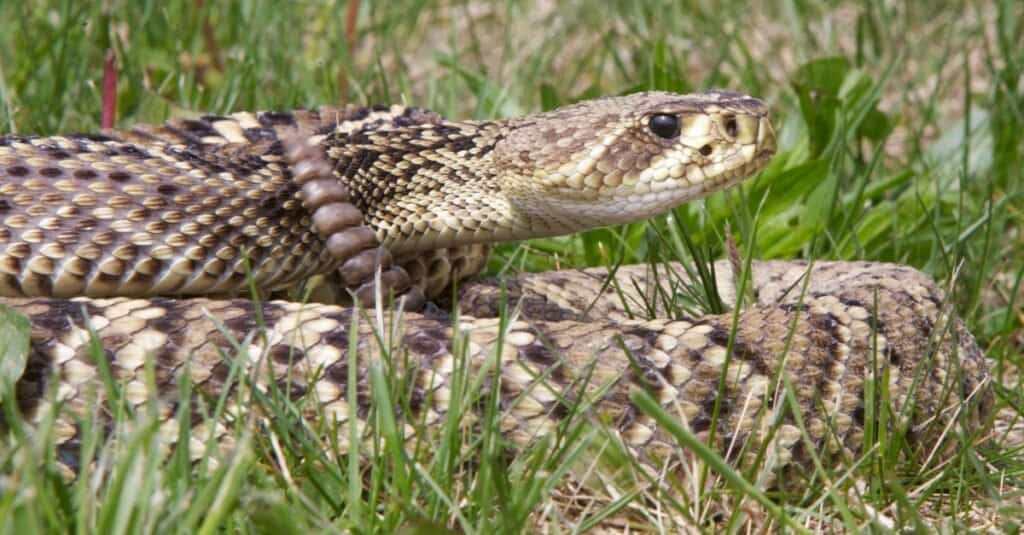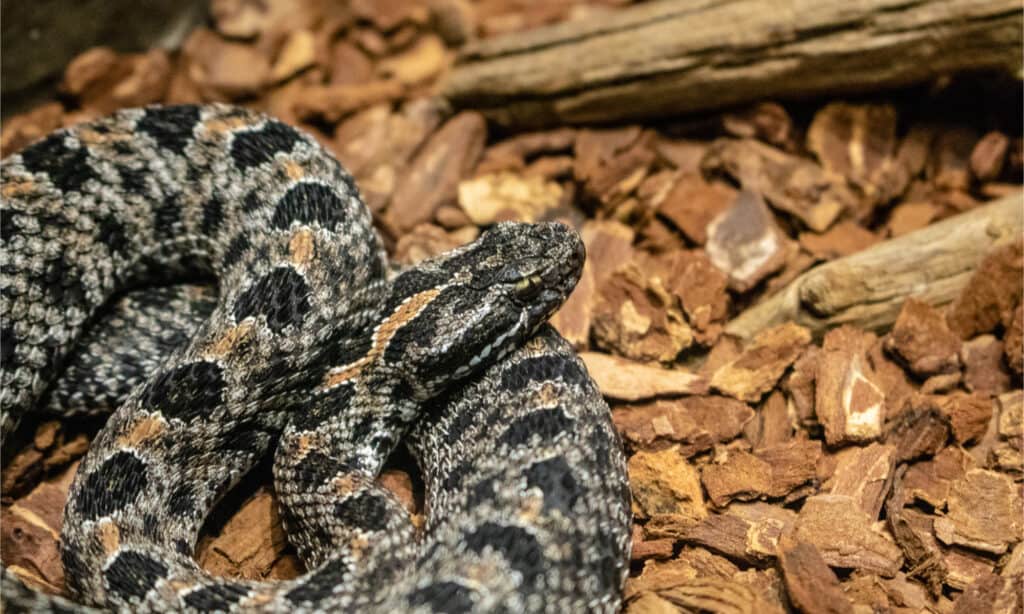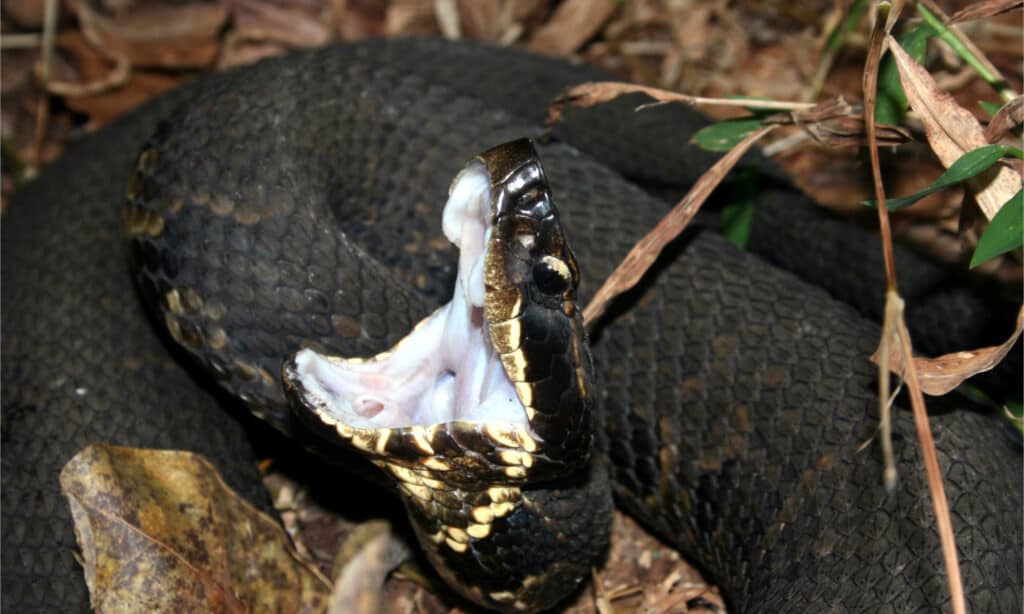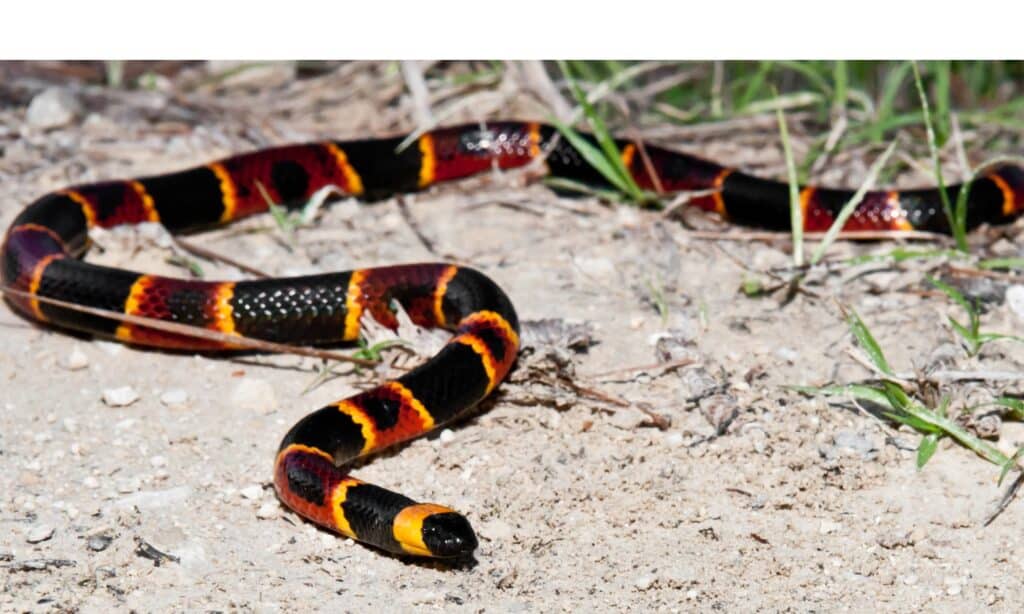Florida has 44 native snake species, and 35 of those snakes live within Central Florida. Of all the snakes in Florida, only 6 are venomous. This article will cover the 4 venomous snakes in Central Florida that you should look out for.
It is easy to confuse venom and poison, as animals use both to hunt and defend themselves. Snakes are actually venomous and not poisonous since they inject their venom with their fangs, and the term poison denotes toxins that are ingested while venom is injected.
Here are 4 venomous snakes in Central Florida you can find.
1. Eastern Diamondback Rattlesnake (Crotalus adamanteus)

The Eastern diamondback rattlesnake was a symbol on one of the first flags of the United States.
©iStock.com/NajaShots
Spread across Florida, eastern diamondback rattlesnakes are a deadly species with venom potentially fatal to humans. Habitats like forests, scrublands, coastal forests, and pinewood savannas are where they prefer to live.
Places with dense vegetation are where they are found, and due to their fear of humans, these snakes are not seen often. Swimming across water lets them travel through wetland areas. Eastern diamondback rattlesnakes can be found in every county within Florida.
How to Identify an Eastern Diamondback Rattlesnake?
The eastern diamondback rattlesnake gets its name from the diamond pattern on its back. Diamondback rattlesnakes grow around 3 to 6 feet, but adults have been measured to reach up to 8 feet in length. This species is the heaviest venomous snake in North America.
Gray, olive green, or near black are the colors of eastern diamondback rattlesnakes. Their scales are dull and roughly keeled. Like other rattlesnakes, they have a rattle on the tip of their tail, which they shake when threatened. Also, their head is large and flat.
Bite of an Eastern Diamondback Rattlesnake
The venom of the eastern diamondback rattlesnake is deadly to humans, but luckily antivenom for this snake is available. Diamondback venom is classified as a hemotoxin that kills the body’s red blood cells and tissues. If not treated, deaths from their bite can happen in as little as 6 hours. Nausea, vomiting, sweating, lightheadedness, and difficulty breathing are some symptoms of their bite.
2. Dusky Pygmy Rattlesnake (Sistrurus miliarius)

The dusky pygmy rattlesnake is the smallest species of venomous snake in Florida.
©Suzanna Ruby/Shutterstock.com
Found in every county within Florida, the pygmy rattlesnake is one of the most common venomous species in its range. This snake is found near wet areas like swamps, marshes, and near creeks. Forests, wetlands, and grassy plains are habitats preferred by this species. Oftentimes, this snake remains hidden under debris, leaf litter, or in other secluded areas, so it is hard to spot.
How to Identify a Pygmy Rattlesnake?
A very small snake, the dusky pygmy rattlesnake is the smallest species of venomous snake in Florida. Dusky pygmy rattlesnakes are around 20 inches long and have thick bodies. Their body ranges from a light gray to darker black color with dark blotches running down their body and a thin ventral stripe. The stripe that runs down their body is usually orange colored, and a small rattle sits on the end of their tail.
Bite of a Pygmy Rattlesnake
The small size of the pygmy rattlesnake and its small fangs make bites from this snake much less severe than larger species. Its small fangs only administer a small amount of venom, which is hemotoxic. Its venom kills cells and skin tissues with a very painful bite. Pygmy rattlesnakes have one of the weaker bites from venomous snakes in Central Florida, but if left untreated, it may cause serious medical issues.
3. Cottonmouth (Agkistrodon piscivorus)

Cottonmouth snakes have a white mouth that gives them their name.
©Psychotic Nature/Shutterstock.com
Also known as the water moccasin, the cottonmouth is a very common species in central Florida that lives near freshwater sources. This snake lives in wet areas like lakes, streams, and marshes. If found in the open, this snake tends to flee while emitting a musky smell when defensive. Cottonmouths are the only venomous water snakes in Florida, and other water snakes are often confused for this deadly species.
Cottonmouth snakes have a white mouth that gives them their name, and they expose this white mouth as a defensive posture. These snakes are most active at night and feed on animals like mice, lizards, and other small mammals.
How to Identify a Cottonmouth?
While cottonmouths are known for their white mouths, there are other things to know about this species. Cottonmouths have visible pits between their eyes, which is also found in similar snakes like rattlesnakes. They have large, broad eyes with vertical pupils.
The cottonmouth holds its head higher when swimming in the water than other water snakes. This is a large species that grows around 2 to 4 feet in length. This snake has large hourglass-shaped band markings that run down its body. The cottonmouth has a dark brown or yellow color. However, as it ages, this color darkens, sometimes blackening completely.
Bite of a Cottonmouth
The bite of a cottonmouth is deadly. This snake has hemotoxic venom, which causes symptoms like pain, swelling, rapid breathing, and damaged tissues. Cottonmouths have deadly bites, but antivenom and medical treatments help prevent deaths. Extremely quick, they can strike at a speed of 2.98 m/s.
4. Eastern Coral Snake (Micrurus fulvius)

The eastern coral snake has a black snout followed by a band of yellow, then black, then yellow or white, then red, then yellow then black all the way down to the tail.
©iStock.com/JasonOndreicka
Eastern coral snakes live through Florida and are common in dry habitats. They are fossorial species and spend most of their time buried underground or hiding under natural debris. They live in wetlands, flatwoods, pine forests, marshes, and sandy habitats. These snakes are among the most venomous species in Florida and are easily identifiable due to the colors they showcase.
How to Identify a Coral Snake?
A medium-sized species, coral snakes, are about 2 feet long when fully grown, but some grow larger. Their coloring and pattern is their most identifiable trait, as their body has large bands. Vibrant black, yellow, and red rings circle their body. Also, they have a glossy look with smooth scales.
Milk snakes are sometimes mistaken for coral snakes, as they have a similar pattern and coloring. The colors of the two species can identify them from one another, as they are slightly different. Coral snake bands have red ones next to yellow ones, while milk snakes have red bands next to black. The common rhyme “Red to yellow kills a fellow. Red to black friend of jack” is how people remember the difference.
Bite of a Coral Snake
Coral snake bites are not common, but if they occur, they can lead to death. There are 3 species of coral snake in the United States, and the eastern coral snake bite has the most potent venom. Damage from the bite is less severe when compared with larger snakes, as their mouths are small.
The venom of the eastern coral snake is neurotoxic and takes a couple of hours for its symptoms to be felt. Symptoms like nausea, vomiting, twitching, paralysis, and vomiting occur from the bite. Antivenom is available to prevent death.
The photo featured at the top of this post is © iStock.com/DaveGartland
Discover the "Monster" Snake 5X Bigger than an Anaconda
Every day A-Z Animals sends out some of the most incredible facts in the world from our free newsletter. Want to discover the 10 most beautiful snakes in the world, a "snake island" where you're never more than 3 feet from danger, or a "monster" snake 5X larger than an anaconda? Then sign up right now and you'll start receiving our daily newsletter absolutely free.
Thank you for reading! Have some feedback for us? Contact the AZ Animals editorial team.






